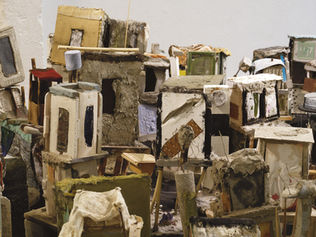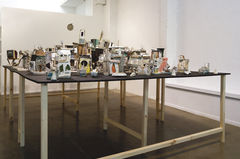Unquiet Dwellings

משכנות (לא) שאננים // שי אלכסנדרוני
בחלל הגלריה נפרשת עיר שלא תוכננה, לא נולדה ממפה או מקו אדריכלי, אלא מצטיירת כדגם גולמי של קיום בשוליים — גוש פיסולי דחוס, גס, המשמש עדות חומרית למה שמתרחש במקום שבו נוף הופך לסבך, כשסדר הופך להישרדות, וכשתבנית מתבקעת מבפנים. לא עיר, לא מחנה, לא שכונה – אלא משכנות לא-שאננים.
משאריות של מגזינים זרים, מחברות אכולות עש, רישומים של אישה אלמונית ושרידי זיכרון שהיו מונחים בארגז בשדרה - כתב האמן את ספרו 'עיר'. במקביל, הוא עסק ביציקות בטון אמורפיות ומהן המשיך להרכבת מבנים מקרטון, עץ חרוך, זכוכיות, בדים קרועים ומתכות חלודות. מכל אלה התגבשה עיר.
אבל זו איננה עיר אמיתית, ואף לא מטפורה לעיר. זוהי עיר שבורה, מעין שיכון דיסטופי, מחנה מעבר, שכונת עוני דמיונית — בתים שהם גם שברי בתים, מקום שהוא גם שארית נוף, מיצב שמבקש לא לתאר מציאות אלא להקים אותה מחדש מההריסות. המבנים עומדים על מצע של בטון וחול, חסרי צל, נעדרי שורש, מזכירים את הפאבלות של ריו ואת הבידונוויל של דרום אפריקה, את מחנות הפליטים, את שכונות הפחונים וגם את פצעי השוליים המקומיים, אלו שאנו חולפים על פניהם במהרה מדי.
בתוך הצפיפות, בתוך הכאוס החומרי, יש סדר פנימי: זהו סדר של גאוגרפיה רגשית, של ניסיון לאחוז בזיכרון, בשפה, בשארית טקסט. האמן פועל מתוך דיאלוג סמוי בין עבודת טקסט לבין עבודת חומר. בין "כתב יד נשי ברור ומעוגל" לבין בטון שבור ומעוות. הוא שואב השראה ממחברות נשכחות ומתרגם אותן למרחב, למסה, לנוף עשוי תבניות.
כמו בהערות שוליים להריסות, הפריטים בתערוכה אינם מייצגים אלא מתקיימים. הם אינם מצביעים על עקירה - הם עקורים. הם אינם מסמנים חורבן - הם ההריסות עצמן. ובכל זאת, כמו בכל נוף אמנותי ממשי, בוקעת מתוכם גם חמלה: חמלה לחומר הפשוט, לחיים המאולתרים, לזיכרון הפרום.
משכנות (לא) שאננים היא תערוכה על החיכוך בין עשייה חומרית לבין חקירה קונספטואלית, על האפשרות לייצר אמנות מתוך הסדק, מתוך הפער שבין תרגום לבין הבנה. זהו ניסיון לייצר שפה חזותית חדשה - שפה שלא מבקשת יופי אלא אמת. אמת סדוקה, דחוסה, אכולת עש, אבל גם חיונית וממשית להכאיב.
ניר הרמט, אוצר
Unquiet Dwellings // Shay Alexandroni
In the gallery space, a city unfolds—one that was never planned, never born of maps or architectural lines. It emerges instead as a raw model of marginal existence: a dense, coarse sculptural mass that bears physical witness to what happens when landscapes turn to thickets, when order gives way to survival, and when structures rupture from within. Not a city, not a camp, not a neighborhood—but unquiet dwellings.
From remnants of foreign magazines, moth-eaten notebooks, anonymous women’s sketches, and memory fragments found in a box on a boulevard bench, the artist compiled his book City. Alongside it, he cast amorphous blocks of concrete and assembled structures from cardboard, charred wood, glass shards, torn fabrics, and rusted metal. Out of these fragments, a city came into being.
But this is not a real city—nor a metaphor for one. It is a broken city, a kind of dystopian housing project, a transit camp, a fictional slum: homes that are also ruins, a place that is also a leftover landscape, an installation that seeks not to describe reality, but to reconstruct it from its wreckage. These structures rest on a bed of sand and concrete, rootless and exposed, evoking the favelas of Rio, the bidonvilles of South Africa, refugee camps, tin shantytowns, and the wounded edges of our own urban margins—those we pass too quickly by.
Amid this dense material chaos, an inner order persists: an emotional geography, an attempt to hold onto memory, to language, to remnants of text. The artist works in a silent dialogue between writing and matter, between a “clear, rounded feminine handwriting” and broken, distorted concrete. Forgotten notebooks are reinterpreted as space, volume, and topography.
Like footnotes to ruins, the pieces in this exhibition do not represent—they exist. They do not point to displacement—they are displaced. They do not symbolize destruction—they are the ruins. And yet, as in any true artistic landscape, compassion breaks through: compassion for humble materials, for makeshift lives, for frayed memory.
Unquiet Dwellings is an exhibition about the friction between material practice and conceptual inquiry, about the possibility of creating art from the crack—between translation and understanding. It is an attempt to form a new visual language: one that does not strive for beauty, but for truth. A truth that is fractured, compressed, moth-eaten—and yet vital, human, and painfully real.
Curated by Nir Harmat














